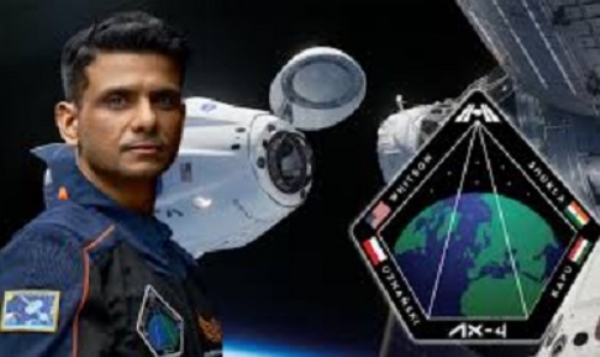


By Dr R B Chaudhary
Group Captain Shubhanshu Shukla’s return from the International Space Station (ISS) on July 15, 2025, after an 18-day mission aboard the Axiom-4 (Ax-4) spacecraft, marks a historic milestone for India’s space program. Shukla’s journey underscores India’s growing expertise in human spaceflight and sets the stage for the Indian Space Research Organisation’s (ISRO) ambitious plan to establish an Indian-led International Space Station by 2035. This article explores Shukla’s contributions, the scientific significance of his mission, and ISRO’s roadmap for a space station.
Shubhanshu Shukla’s Trailblazing Mission
Shukla, the first Indian to live and work aboard the ISS, became only the second Indian astronaut in space, following Rakesh Sharma’s 1984 mission on a Soviet spacecraft. Shukla, a 39-year-old Indian Air Force officer, served as the mission pilot for Ax-4, a collaborative effort involving ISRO, NASA, the European Space Agency (ESA), and Axiom Space. Launched on June 25, 2025, aboard SpaceX’s Dragon spacecraft, Shukla and his crew—Peggy Whitson (USA), Slawosz Uznanski-Wisniewski (Poland), and Tibor Kapu (Hungary)—conducted over 60 experiments, including seven designed by ISRO.
Shukla’s experiments focused on microgravity research critical for long-duration space missions. These included studies on sprouting moong and methi seeds, myogenesis (muscle cell growth in zero gravity), cyanobacteria, microalgae, and Indian strains of tardigrades—resilient microorganisms capable of surviving extreme conditions. A notable experiment involved growing microalgae as a sustainable food source, a breakthrough for future space exploration. Shukla’s playful demonstration of a floating water bubble, where he described himself as a “water bender,” captured public imagination.
The mission, costing ISRO approximately ₹548 crore ($59 million), covered training, launch logistics, and scientific research, with no direct salary paid to Shukla, emphasizing the mission’s focus on knowledge acquisition. His hands-on experience in docking, crew coordination, and emergency protocols provides invaluable data for ISRO’s Gaganyaan program, set for 2027.
ISRO’s Space Station Vision
ISRO’s announcement of a potential Indian-led International Space Station by 2035 has generated significant excitement. ISRO Chairman S. Somanath outlined plans for a modular station, starting with a single module launch by 2028. Initially designed to host three astronauts at an altitude of 120–140 km, the station could later operate at 400 km for extended missions of 15–20 days. This follows the Gaganyaan mission, which aims to send Indian astronauts into orbit using an Indian-built spacecraft and launch vehicle.
The proposed station could serve as a hub for microgravity research in materials science, biology, and astrophysics. It aligns with ISRO’s long-term goals of lunar and interplanetary exploration, including a planned astronaut mission to the Moon by 2040. Shukla’s Ax-4 mission has provided critical insights into orbital operations, crew health, and experiment management, directly informing the station’s development.
Global Collaboration and Challenges
ISRO’s space station is envisioned as a platform for international collaboration, potentially involving NASA, ESA, and other agencies, mirroring the ISS model. Somanath’s openness to partnerships could reduce costs and enhance scientific outcomes, positioning India as a leader in the post-ISS era, with the current station set to retire by 2030. However, geopolitical tensions and competition from China’s Tiangong station and private ventures like Axiom Space could complicate collaborations.
Technical challenges are significant. ISRO must develop advanced life-support systems, radiation shielding, and docking mechanisms. Investments in reusable launch vehicles and propulsion systems aim to keep costs low, leveraging India’s reputation for frugal engineering, as demonstrated in the $74 million Mangalyaan mission. Shukla’s mission has enhanced ISRO’s expertise in real-time telemetry, emergency response, and crew coordination, critical for the space station’s success.
Domestic and International Impact
Shukla’s mission has sparked widespread pride in India, with celebrations from leaders like Smriti Irani, who called it a “giant leap for Indian space exploration.” Public enthusiasm is evident, though some question the 2028 timeline for the space station’s first module due to its complexity.
Funding remains a challenge, with the government balancing space ambitions against terrestrial priorities like healthcare. Internationally, ISRO’s cost-effective approach is praised, but the feasibility of the 2028 deadline is questioned, given the need for extensive post-Gaganyaan testing.
Broader Implications
Shukla’s mission and ISRO’s space station plans could democratize space exploration, inspiring nations like Brazil or South Africa. The project is expected to boost India’s STEM education and aerospace industries, driving innovation and job creation. Shukla’s outreach efforts, including interactions with students and Prime Minister Narendra Modi, have inspired a new generation.
At The End
Shubhanshu Shukla’s Ax-4 mission has positioned India as a rising star in human spaceflight, providing critical experience for the Gaganyaan program and ISRO’s space station ambitions. India’s space station is a bold vision, signaling its intent to lead in the next era of exploration. Despite technical, financial, and diplomatic challenges, ISRO’s track record and Shukla’s success suggest a bright future for India among the stars.
(#Other is Senior Journalist/science communicator associated with the Hindusthan Samachar as Representative of Tamilnadu State)
References/Further Reading/Citations
1) The Guardian. (2025). “India’s ISRO Eyes International Space Station by 2035.” Retrieved from [The Guardian website].
2) Nature. (2025). “Shukla’s ISS Mission Boosts ISRO’s Space Station Plans.” Retrieved from [Nature website].
3) The Indian Express. (2025). “Shubhanshu Shukla’s Axiom-4 Mission: A Leap for Gaganyaan.” Retrieved from [The Indian Express website].
4) Hindustan Times. (2025). “Shubhanshu Shukla Completes 7 Experiments on ISS.” Retrieved from [Hindustan Times website].
5) CNBC TV18. (2025). “Shubhanshu Shukla’s ISS Mission Cost ₹548 Crore.” Retrieved from [CNBC TV18 website].
6) The Economic Times. (2025). “Shukla’s Mission Strengthens India’s Space Ambitions.” Retrieved from [The Economic Times website].
7) India Today. (2025). “Gaganyaan on Track: ISRO Chief on Shukla’s Return.” Retrieved from [India Today website].
8) Business Standard. (2025). “Shukla’s Experiments Advance Life Sciences for Space.” Retrieved from [Business Standard website].
8) The Hindu BusinessLine. (2025). “Shukla’s Odyssey Enhances Gaganyaan Mission.” Retrieved from [The Hindu BusinessLine website].
9) Science. (2025). “ISRO’s Technical Challenges for Space Station.” Retrieved from [Science website].
9) Scientific American. (2025). “India’s Frugal Space Strategy Targets Orbital Station.” Retrieved from [Scientific American website].
10) The Hindu. (2025). “ISRO Faces Funding Challenges for Space Station.” Retrieved from [The Hindu website].
11) The New York Times. (2025). “India’s Space Station Plan: Ambitious but Feasible?” Retrieved from [The New York Times website].
12) Business Today. (2025). “ISRO’s Role in Saving NASA’s Ax-4 Mission.” Retrieved from [Business Today website].
13) X posts. (2025). Public reactions to Shukla’s mission and ISRO’s space station plans, accessed July 16, 2025.
---------------
Hindusthan Samachar / Dr. R. B. Chaudhary








